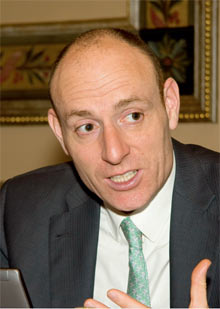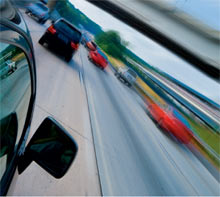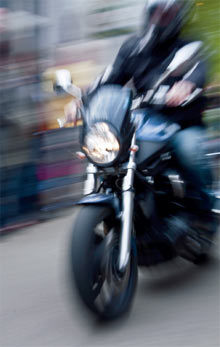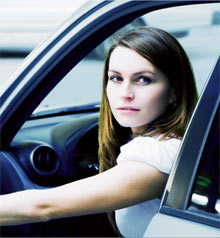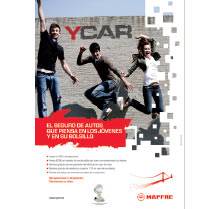Luis Peña: Head of Analysis and Research Department forming part of the MAPFRE FAMILIAR Strategic Planning and Innovation DivisionMISCELLANEOUS
Luis Peña was born in Madrid on 20 June 1971. He is married and has three children.
He is a law graduate and an ICADE graduate in business sciences. He holds the INESE master in motor insurance degree and an MBA executive degree from the University of Alcalá de Henares.
He has spent his entire professional career in MAPFRE FAMILIAR, where he started to work in 1995.
He is currently Head of the Analysis and Research Department within the MAPFRE FAMILIAR Strategic Planning and Innovation Division.
"Until now we Insurers had paid more attention to the chaims history in our tariffs than to what are called psycho-physical factors" The objective of the YCAR product of MAPFRE FAMILIAR, a modality known as pay per use is to incorporate the driver’s habits behind the wheel in the price of the insurance, according to the results of a never-ending study. This is the first time that an innovation like payment per use in motor insurance has been introduced in Spain, which could revolutionize the entire system of current rating. For the time being, as the pioneers, MAPFRE FAMILIAR have reached some conclusions although three more years will be required for greater reliability. This interview brings us closer to knowing the objectives, strategies and steps that are being taken.
In a continuous process of innovation such as
the one you are developing what is the prevailing
philosophy?
There are many tools and a large amount of
intuition. In addition we are looking for innovations
that have a strategic projection, in other words,
best for today but with a vision of the future. The
starting philosophical point is always the strategic
plan. The client has been placed in the centre of
the entire MAPFRE company structure and therefore
in the middle of all those areas that make
up MAPFRE FAMILIAR. We are now all rowing in
the same direction, we know the priorities. All
our activity is focused on client satisfaction. The
client gains advantages from our ceasing to be
a single branch entity and becoming a multibranch
company. For example we are implementing
discounts for integrating various policies,
something that was not possible before, because
each unit, each company, had its own results
account to protect.
Does this involve massive innovation?
Yes, but it is not specific to the insurance sector. For
some years now the banking sector has been refining
its product matrices and knows which are the ones
that better bind the clients and on the basis of this
knowledge it establishes the offers. This is that we
are applying now. A client value matrix exists, not
all clients are the same, because some are profitable
and others unprofitable, and in this case who are
we going to treat better? Undoubtedly the most
profitable ones. What is true is that it is ever harder
to grow in personal lines business and therein lays
the importance of policies aimed at reducing the
rates of non-renewal. We have more than seven
million clients in Spain and are well aware that we
can grow from inside, enhancing the offer of products
for our existing clients without prejudicing the
incorporation of new clients.
The philosophy’s starting point is always the strategic plan and the client has been placed in the centre of the entire MAPFRE business structure
One of the creations of the MAPFRE FAMILIAR
Innovation Division is the product aimed at young drivers known as “Generation Y”, which
has evolved and become a star product – YCAR.
What objectives were being sought and how
was it born?
After a market study and a very rigorous analysis
phase the conclusion was reached: that it was
worthwhile experimenting with the possibility of
incorporating new risk factors related to road
safety in the premium calculations, such as the
type of roads used and the driving time bands.
Until now insurance companies had taken little
account of these factors because in the current
rating system the claim history carries more
weight than the psycho-physical factors; in other
words, we know in the context of other variables
on what day of the week the client drives, the
routes that are followed, whether the client
drinks and drives. This is important because for
example in the field of road safety we know that
70% of the fatal accidents at weekends occur
on secondary roads.
To transfer this experience that is already in
progress in Spain we suppose that the way
others functioned was examined. In addition
we have the problem of privacy, ensuring that
the user’s behaviour does not transcend beyond
this objective of adjusting the premium according
to the vehicle’s use.
Indeed, before the experience of Great Britain
where this system is fairly extended we have
the Progressive system in Texas in 1998. The
American experience revealed two defects: privacy
problems that obliged the Americans to
abandon the GPS and the cost / benefit ratio. If
we go back to the roots this is an idea of the
Canadian Economics Nobel Prize winner William
Vickrey, who criticised the inefficiency of rating systems because they did not take into account
the intensity of use. If one turns the lights off
one pays a lower electricity bill but if you leave
the car at home you do not pay less for the
insurance. Two approximations were made; one
was paying at the petrol pumps, in other words
insurance as an added price on petrol to take
into account the use intensity: more use, more
petrol and more premium. The same happened
with tyres which became known as “insured
tyres”. Vickrey was quite a visionary but he did
not get it right because at that time there were
no applied technologies. His considerations can
be taken up again when satellite technology
devices are incorporated in the vehicle, be it
GPS, Glonass or Galileo, which allow measurement
of the use intensity variables in an objective
way: kilometres driven, speed, night time or
daytime driving, for example.
The competitive advantage lies in tariff refinement and the company that will have the advantage is the one that has the best statistical base, the one that can personalise more
When MAPFRE FAMILIAR implements the pay
per use system in Spain in an experimental
way as the basis for a wide study, what steps
are taken and how many drivers are involved?
In principle the product is aimed at young drivers.
Between 5 November 2007 and the first week
of September 2008, 10,000 young drivers of
between 18 and 27 years old subscribed to the
experiment. Today there are more than 16,000.
The segment of the population was deliberately
limited to make the conclusions more valid. This
group covers all types of vehicles and all geographic
locations. The greater the diversity the
better it is for the study phase. This is why we
substantially subsidise these new young Insureds,
even with discounts of 20% on the standard
young drivers’ premium in MAPFRE. We will
need three years to reach solid conclusions.
Does the installation of a satellite based monitoring device, in exchange for cheaper insurance
entail a loss of confidentiality where the
person’s habits are concerned?
We use the GPS system but the data that we
receive are always aggregated and we cannot
access detailed information. Knowing exactly
where the vehicle is located would add nothing
where the payment for use tariff is concerned.
There are only two times when the information
on the exact position of the vehicle is collected:
in the event of theft (to be able to recover the
vehicle) and in the case of an accident (to be able
to send emergency medical services).
Exactly what types of controls are exercised?
The terminal transmits data that go to the server
of an external computer system provider and the
provider has the data associated to a PIN, an
identification code that contains no data of a personal
nature. When the computer system provider
sends the data to MAPFRE FAMILIAR within an
automated process, it is done without the details
of the vehicle’s exact position defined by the GPS
longitude and latitude coordinates. This is what
we call the privacy firewall and this is what AENOR
(Spanish Standards Institute) certifies. I would stress again that in the YCAR insurance
MAPFRE FAMILIAR do not know the exact position
of the vehicle except in the case of impact
or theft. At these times the advantage of having
the GPS terminal installed in the vehicle is most
appreciated. In the case of impact, to say a very
sudden reduction of speed, it is the car that
transmits the signal to the system provider,
which in turn alerts us.
There are only two times when information on the exact position of the vehicle is collected with GPS: in the event of theft and in the case of an accident
Have lives been saved thanks to the installation
of this system?
The first thing we do on receiving an impact alarm
signal is a phone call to the Insured’s mobile
number. If we do not manage to speak to the
Insured a basic protocol is initiated. From a certain
detected impact intensity and in the absence of
telephone communication we call 112 and this is
an added value that we provide. The 112 emergency
services have validated the credibility of
our system and above certain thresholds we know
that a serious accident has occurred with injuries
and therefore the 112 emergency medical treatment
service is automatically notified. We have
concrete experience in this sense.
And in the case of theft?
We can know the exact position of the vehicle but
as a guarantee for initiating monitoring we require
that the owner has reported the disappearance
to the police. We have recovered practically all
stolen vehicles with few exceptions.
What are the characteristics of the GPS device
installed in the vehicles?
It is small, about the size of two packets of
cigarettes and it is equipped with three peripherals:
a GPS aerial to recognise the position; a
GSM GRPS aerial to transmit the data by mobile
telephony and the sudden speed reduction meter
that reports a possible collision. This is all hidden
in the vehicle.
Could the installation of this device distort
behaviour behind the wheel when the driver
thinks he is being watched? Does the monitoring
extend to other countries in the European
Union?
It is perfectly fine when somebody modifies their
habits to improve them. This effect is diluted over
time. Regarding monitoring in other countries it
continues to function in principle and in fact we
also provide the vehicle recovery service in the
case of theft in France and Portugal.
What feelings does this product generate when
it is the price that varies most?
The price is not the only variable. You can compete
on price but added value services exist. A
father values the importance of having a system
that guarantees medical treatment when an
impact of a certain intensity occurs. When a
company like MAPFRE FAMILIAR puts all its
efforts in promoting a project like this one something
positive must be behind it - advantages
for all the parties. We are sure that the future
of motor insurance will follow this path and that
times of crisis are the most propitious for innovation.
We hope to have as much success as
possible although I would not dare to give an
estimate of the number of policies that we are
going to achieve with this product.
We will need three years to reach solid conclusions
Are you going to incorporate the satellite based
device in motorcycles?
Yes. In fact in July 2009 MAPFRE FAMILIAR
started marketing “eBike10”, an insurance for
motorcycles of 125 or more cc, linked to the
installation of the satellite based device to help
the motorcyclist at all times: it allows locating
the motorcycle in the case of theft, identification
of attempted sabotage, falling over when parked
or loss of battery. With eBike 10 MAPFRE FAMILIAR
have betted heavily on innovation and safety
for motorcyclists, because the device will provide
help in emergency situations. According to recent
data the risk of dying in a road accident when
driving a motorcycle is 17 times higher than that
of when driving a saloon car and that 41% of
motorcyclists’ deaths are due to leaving the road.
Given these figures reducing the time of treating
the injured motorcyclist thanks to eBike10 in
many cases will prove vital.
Pay per use - a pioneering experiment in Spain
What is the objective of the study of your insurance habits behind the
wheel?
We are looking for experience on these new risk factors that we do not
know and that road safety tells us have an influence on the causes of
accidents. We are handling data that is not contained in the General
Directorate of Traffic statistics and we aim to compare the data. This
involves a pioneering experiment and one of the premises is that the
study is never-ending; it has no expiry date even though we will have to
wait at least three years to reach valid conclusions.
Are new Insureds being incorporated in the sampling?
Yes. Our YCAR product is aimed at drivers aged up to 30 but the purpose
is that it is maintained throughout the policy’s life. To encourage it we
offer substantial discounts on contracting the insurance and in addition
we give away fuel cards, exchangeable at petrol stations that can reach
more than Euros 600 in the event of the profiles defined as good driving
being met.
Since the study and the derived conclusions constitute a long and
complex process what is your initial assigned budget? Will other
companies in the market follow your footsteps?
The official figure is Euros 10 million and in answer to your second
question the truth is that we want the market to copy us because in this
way the concept will be generalised even though we are the first. The
competitive advantage lies in tariff refinement and the company that will
have the advantage is the one that has the best statistical base, the one
that can personalise more.
What are the first conclusions reached through the implementation of the YCAR product?
First of all not all young drivers are the same. There is a predominance of single drivers of the most powerful cars and this effect is multiplied when we speak of weekends. From Monday to Thursday women drive more than men; at weekends the man predominates with powerful vehicles, above all in the evening or night. Men start to use their car in the mornings before women, between 6.30 am and 7 am. Women use their cars in the mornings between 8 am and 9 am. We have analysed three driving groups by use of vehicles; the constant, the active, in other words the working days and leisure days and those that only use the vehicle at weekends. There are large differences in the maximum speeds and in the distances travelled. We have noted that the leisure drivers travel larger distances because they drive on Saturdays and Sundays, as compared to the constant drivers even though they use the vehicle on more days. This takes the myth out of certain aspects of road safety. There is no relation with age; the relation is with the journey. The day of most vehicle use is Friday.
http://www.mapfre.com/portal/generacion-young/generacion-young.shtml
